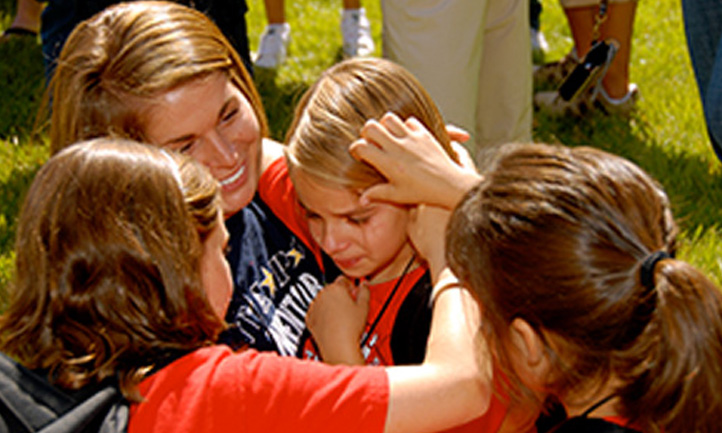Helping Military Kids with Traumatic Death
Author: Linda Goldman
Ordinary fears are a normal part of a child’s developmental growth, and children create internal and external mechanisms to cope with these fears. But a child’s ordinary fears can be transformed into very real survival fears in the face of severe trauma. After children experience the death of a parent, they often feel alone and different. Frightened because their once comfortable world now seems unpredictable and unsafe, they may react in ways that we as adults can truly not judge, understand, or anticipate. The impact of a dad’s or mom’s death in the military can be so traumatically disturbing that the terror involved with the death and the way the parent died may override a child’s ability to grieve in a natural way, and share sadness and frustration.

Events can cause panic, stress, and extreme anxiety in kids’ lives, and the feelings are heightened with each new instance reported in the media. The terror that grips our children in these circumstances emerges from situations that suddenly overwhelm them and leave them feeling helpless, hopeless, and unable to cope. Trauma is defined by the Encarta® World English Dictionary as “an extremely distressing experience that causes severe emotional shock and may have long-lasting psychological effects.” This unexpected and shocking event destroys a child’s ability to cope and function in a normal way.
Children can suffer from a state of trauma that can develop into Post-Traumatic Stress Disorder, in which present events trigger memories of trauma resulting in panic, anxiety, disorientation, fear, and all the psycho-physical feelings associated with the traumatic memory.
Signs of traumatized children
Seven-year-old Joey’s dad was killed in Iraq. He constantly questioned Mom. “Tell me exactly what happened. Did my Dad suffer?” Joey had nightmares and regressed to bedwetting. Tyler’s dad was killed by a stray bullet during military combat. His father would always tell him “Nothing can stop me from coming home.” Tyler constantly worries about where the bullet hit him, did it hurt him, was he unprotected, and did he die instantly. He began having stomachaches and panic attacks, worrying his mom could get killed too. Jonathan’s dad was killed in a firefight in Iraq. Instead of being honored as the son of a military hero, he was often victimized on the playground by a school bully. Jonathan kicked him and both boys were punished. His grades dropped from straight A’s to F’s after his dad died.
Many young people may experience physical, emotional, cognitive, and behavioral symptoms. These signals range from stomachaches and nightmares to poor grades, isolation, depression, regression, and hostility.
Caring adults need to recognize the signs of grieving and traumatized children, and they need to be aware of the techniques and resources available to help bring safety and protection back to the child’s inner and outer world. For example, listening to children’s thoughts and feelings, and providing a safe means of expression helps teachers, parents, and educators reinforce their ability to ensure a safe and protected environment.
Traumatized children tend to recreate their trauma, often experiencing bad dreams, waking fears, and recurring flashbacks. Young children have a very hard time putting these behaviors into any context of safety. Many withdraw and isolate themselves, regress and appear anxious, and develop sleeping and eating disorders as a mask for the deep interpretations of their trauma. Young children engage in post-traumatic play by compulsively repeating some aspect of the trauma.
The most common identifying factors that children are re-experiencing the event are play reenactment, nightmares, waking memories, and disturbing thoughts and feelings about the event. Sometimes kids avoid reminders of the traumatic event and show little conscious interest. Many traumatized children exhibit hyperarousal by increased sleep problems, irritability, inability to concentrate, startle reactions, and regressive behaviors.
When caring adults can identify traumatized kids, they can normalize grief and trauma signs and develop ways kids can express their feelings and emotions. Parents, educators, and other caring professionals can model, present, and support comfortable ways to bring safety and protection back into kids’ lives.
Young children developmentally live in an egocentric world filled with the notion that they have caused and are responsible for everything. George’s dad was deployed to Iraq twice. Over and over George explained to his teacher, “It’s my fault my dad died. I should have made him stay home from Iraq.” Some kids may also feel survival guilt. They may think, “Why am I living when so many others have died?” Adults can reframe guilt and magical thinking from “What could I have done?” to “What can I do now?”
At-risk behaviors
Children may begin to exhibit at-risk behaviors after a traumatic event. The frequency, intensity, and duration of these behaviors are important factors to consider. Children may experience post-traumatic stress, revisiting the traumatic event through outside stimulus like photos, music, and the media, or by reliving the sights and sounds of the tragedy in their minds. Expect children to re-experience a degree of their original trauma on the anniversary of their parent’s death.
The following behaviors may be indicators that a child may benefit from professional help:
- Sudden and pronounced change in behavior
- Threat of suicide or preoccupation with suicide, evidenced through artwork or writing
- Harmful acts to other children or animal
- Extreme confusion or incoherence
- Evidence of substance abuse – drugs, alcohol, etc.
- Sudden change of grades
- Avoidance or abandonment of friends
- Angry or tearful outbursts
- Self-destructive behavior
- Inability to eat or sleep
- Over-concern with own health or health of a loved one
- Giving away important possessions
- Sudden unexplained improvement in behavior or schoolwork
- Depression, isolation, or withdrawal
Activities that help kids express thoughts and feelings
Helping children to establish a sense of order in an ever-changing and chaotic world is important. Not only do we want our kids to realize they are survivors of a difficult event, but they also need to know that their life still has continuity and meaning. Parents and educators working with traumatized children should keep to the daily routine as much as possible. This allows kids to feel a renewed sense of security.
Establishing family activities also has a reassuring effect on children. Preparing meals together, eating dinner as a family, reading stories aloud, or playing family games can help to reestablish a sense of normalcy to kids’ lives. It is important to initiate safe places for kids to express their ideas. This can be done by finding quiet times at home, in the car, or on a peaceful walk. Being with children without distractions can produce a comfortable climate to begin dialogue. Bedtime should be a reassuring time, too. Often, this is the time children choose to talk about their worries. Parents can consider an increase in transition time, storytelling, and book reading to create a peaceful, uninterrupted nighttime environment.
Hope for the future
The sudden death of a mom or dad in military service can shatter a child’s emotional and physical equilibrium and stability. Too many boys and girls experience fear, isolation, and loneliness after a parent’s traumatic death. Faced with a myriad of losses ranging from parental death, moving, change of school, reduced income level, and public mourning, many children are left in a world where they see no future and no protection.
One goal of trauma work with children is to restore safety and protection to children who have experienced the loss of a parent in combat. Another goal is to provide parents and youth workers with information, understanding, and skills related to the issues creating trauma. With these tools we can help our children become less fearful and more compassionate human beings, thereby increasing their chances of living in a future world of increased inner and outer peace.
 By Linda Goldman, FT, LCPC, NBCC: Linda Goldman is a Fellow in Thanatology: Death, Dying, and Bereavement (FT) with an MS degree in counseling and Master's Equivalency in early childhood education. She is a Licensed Clinical Professional Counselor (LCPC) and a National Certified Counselor (NBCC). She currently has a private grief therapy practice in Maryland where she works with children, teenagers, families with prenatal loss, and grieving adults. Linda is the author of Life and Loss: A Guide to Help Grieving Children; Children Also Grieve; and Great Answers to Difficult Questions About Death. Visit her website at www.childrensgrief.net
By Linda Goldman, FT, LCPC, NBCC: Linda Goldman is a Fellow in Thanatology: Death, Dying, and Bereavement (FT) with an MS degree in counseling and Master's Equivalency in early childhood education. She is a Licensed Clinical Professional Counselor (LCPC) and a National Certified Counselor (NBCC). She currently has a private grief therapy practice in Maryland where she works with children, teenagers, families with prenatal loss, and grieving adults. Linda is the author of Life and Loss: A Guide to Help Grieving Children; Children Also Grieve; and Great Answers to Difficult Questions About Death. Visit her website at www.childrensgrief.net
